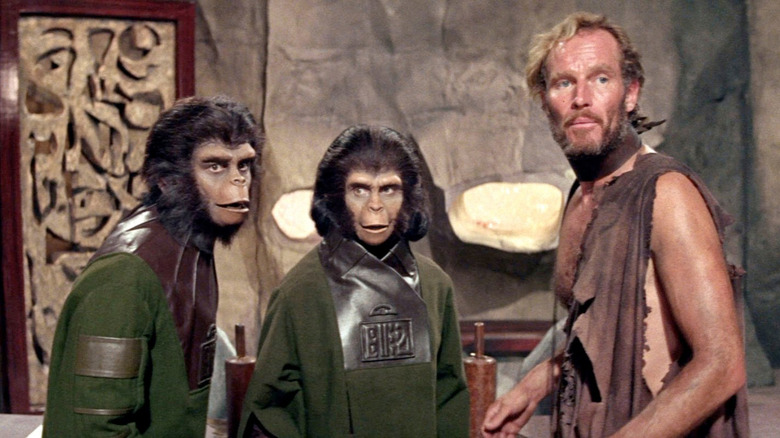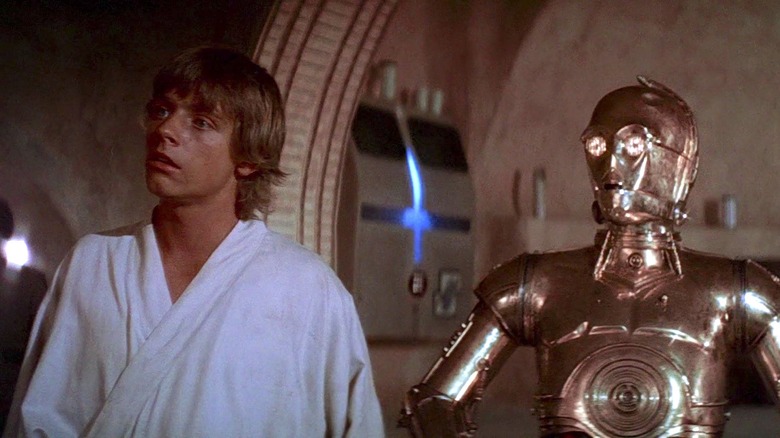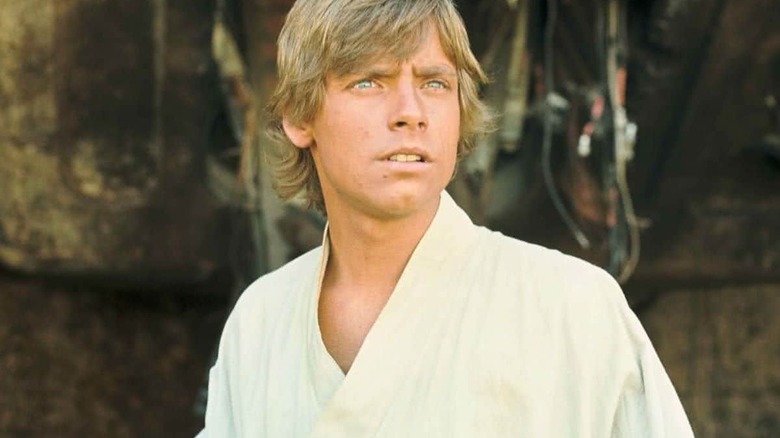Mark Hamill Boldly Predicted Star Wars Stealing Planet Of The Apes' Sci-Fi Throne
It's well known to "Star Wars" buffs that director George Lucas, when negotiating his contract with 20th Century Fox, insisted on keeping the "garbage rights" to the movie. In the mid-1970s, "garbage rights" referred to merchandising tie-ins like toys and lunchboxes. Although some movies had been successful with such merchandising in the past, no studio had ever made a notably substantial amount of money from them, hence the nickname. This move proved to be short-sighted for Fox and prescient for Lucas, as "Star Wars" kicked open the doors to a movie marketing bonanza that we are still experiencing to this day. "Star Wars" toys sold so quickly, that toy manufacturers had to sell empty boxes to fans while they produced more three-inch Luke Skywalkers. Once the toys were made available again, the boxes would be filled.
And while "Star Wars" might have kicked the door open in terms of marketing and toy manufacturing, a sci-fi hit from nine years previous actually unlocked it first. Franklin J. Schaffner's 1968 film "Planet of the Apes" slowly discovered, as its many sequels were released throughout the '70s, that merchandising could be a lucrative offshoot of a cinematic hit. Toy collectors will be intimately familiar with the Mego Corporation, a toy line that produced eight-inch action figures based on licensed characters. Their gimmick was that their figurines all wore real cloth costumes. In 1974, after the release of "Battle for the Planet of the Apes" and during the run of the "Apes" TV series, Mego started to produce their own "Apes" toys, and they sold incredibly well.
It could be argued that "Apes" is the more important film when it comes to toy merchandising. It was, at the very least, the reigning champion of sci-fi entertainment for the better part of a decade.
We got the Clockwork Orange guy
"Star Wars" star Mark Hamill also felt, in 1977, that his own movie was in a great position to be a supplanter of the Apes.
In 1988, Hamill was interviewed by the Lucasfilm Fan Club newsletter, handily reprinted on StarWarsNews.Net, and he claimed that in '77, he saw "Star Wars" success on the horizon. He didn't predict just how earth-movingly large "Star Wars" would be — no one predicted that — but he did know that Lucas' film was poised to take the lead in the realm of sci-fi. "Apes" was a heady satire about the downfall of humankind, ending on a bitter, nihilistic image that cements humans' violent idiocy. "Star Wars," in contrast, was a whimsical adventure films that little kids could enjoy. Hamill said:
"I didn't expect it to be the smash it was but I thought it would be popular. I remember saying to someone, 'I bet you this thing is bigger than 'Planet of the Apes."' I said that because it [had] humor and lots of good action/adventure. It still reads wonderfully even without any of the special effects."
Hamill, although in his mid-20s during the shooting of "Star Wars," also took note of who was working on his film. He recognized that a set designer from "A Clockwork Orange" and "Phase IV" was going to be working on "Star Wars," and that filled the actor with hope. He said:
"When I realized they were getting John Barry to do the art direction and the other elements that were shaping up, I said, "This is going to be popular." I thought it would be real popular with high school and college students but I didn't know it had the big crossover from little children to adults."
The sequel
When "Star Wars" began breaking box office records in 1977, Hamill admitted that he didn't think so much about merchandising or lasting cultural presence so much as a sequel. Evidently, Lucas was always talking about how "Star Wars" was meant to be a serialized entertainment like "Flash Gordon" shorts from the 1930s and '40s, and Hamill was excited to get started. He also understood that "Star Wars" was the kind of film that would only happen to an actor once, and that they would have to eventually twist off and explore other career avenues. In that regard, Hamill is likely pleased to have been proven wrong. "Star Wars" has proven to have some of the longest legs in Hollywood history. He said:
"... I was thinking in terms of whether we were going to make the second one, which depended upon the success of the first. I thought that we would make the second one, though. It was just a hunch but it came true. You know, the tremendous success of 'Star Wars' was something I thought would happen to all of us — the Star Wars cast — once in a lifetime. Then Harrison Ford went out and did 'Raiders of the Lost Ark' and disproved my whole theory!"
An interesting piece of trivia: Mego, the "Apes" manufacturers, rejected the offer to make "Star Wars" toys, forcing Lucas over to Kenner, who made smaller, three-inch toys. Kenner made a killing with its line of littler, imminently chewable figurines. For many, the toys are just as important as the movies themselves, and consuming tie-in merchandise has become a vital part of the "Star Wars" experience. Some of the Kenner dolls are very valuable. Many aren't.


